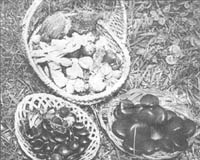A traditional Christopher Columbus legend credits the "sea heart" bean with
inspiring him to search for the lands where he thought the beans grew. This bean
is a large, heart-shaped seed that grows on "money ladder" [sic: "monkey laddar"]
vines in the Costa Rican forest. The pod, one of the world's largest, grows up
to six feet in length. Like other sea beans, some sea hearts escape the forest
by washing into rivers that eventually enter the ocean.
The sea heart is also called "Columbus Bean," and has a very hard shell that
can be polished. Sea hearts are found on European beaches also, where they have
been carried by the Gulf Stream. Europeans used to make them into snuffboxes and
lockets by cutting them in half and attaching hinges, and sometimes elaborate
silver decorations.
Polished to a glossy shine and hung from a chain, the sea heart makes an attractive pendant for a beloved.
Another common find in Florida is the "hamburger bean," another jungle vine seed. There are a number of varieties of this bean, which, with its round shape and dark band, looks like a miniature hamburger. Occasionally these arrive still in the seedpod, which is leathery and covered with prickly, stinging hairs. Hamburger beans also can be polished and are often made into jewelry. In Europe, they are called "horse-eye" beans.
The "sea purse" resembles the hamburger bean, but is shaped like a little
purse, with a thinner band and a "zipper." The "zipper" is actually a scar left
from the place where the seed was connected to the pod.
Sea pearls, also called "nickernut" for the nickar plant that produces them, come in brown, yellow, and gray. The gray ones come from a species native to Florida, and are the most common ones around. These round, hard seeds are collected on many islands and used like marbles in a board game. Nickernuts used to be worn as an amulet to ward off the "evil eye."
"Mary's bean," also called "Crucifixion bean," because of the indented cross on the surface, is a rare find. Treasured because of their scarcity, religious symbolism, and traditional powers (holding a Mary's bean is supposed to insure a safe childbirth), these beans are often passed down from mother to daughter.
|
Seeds from plants that grow in Florida are often found locally.
These include coral beans, from the colorful coral flowers, mango seeds, moonflower
seeds from the dune plant also called "railroad vine," and tropical almonds.
Sea beans are often found with teeth and bite marks. Sometimes the damage occurs before the seed ever leaves its jungle home. Star nuts acquire scars from the teeth of forest monkeys who eat the fruit from around the seed. A seabeaner, vacationing from Peru, watched a pacu, which is a sort of a vegetarian piranha, munching on a hamburger bean.
Other seeds may be marked by the jaws of young sea turtles feeding on the marine organisms that attach themselves to floating objects.
What else can be done with sea beans? Then can be sprouted and grown indoors
in potting soil, but they need protection from cold winter temperatures and plenty
of room. Some of them can grow up to an inch a day. Hard coated sea beans must
be scored with a saw, or have a hole drilled in them, so that freshwater can reach
the embryo inside.
Most of the sea beans found on our local coast come from Central or South
America and the Caribbean. A branch of the Equatorial Current, which passes by
these areas picking up debris originating in tropical rainforests, enters the
Gulf of Mexico. Sea beans and other flotsam and jetsam often get tangled up in
the sargassum mats that float with the current. The best time to find sea beans
here is when the wind blows hard from the southwest, and especially when sargassum
weed is blowing in on the wind.
To learn more about sea beans, sign up for The
Drifting Seed newsletter (P.O. Box 510366, Melbourne Beach, FL 32951), or visit
Topsail Hill State Preserve in south Walton. The RV Park office has pages
of sea beans for kids to color, and real sea beans to look at. Call the park at
267-0299 and leave your name if you are interested in one of the upcoming sea
bean workshops conducted by Karen Kromer. Or, for the serious seabeaner, the 2002
Beachcombers Festival and Sea Bean Symposium will be held on Oct. 18 and 19 at
the Cocoa Beach Public Library. Information on the symposium is on the website, www.seabean.com.
|
![]()
